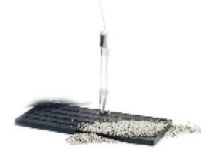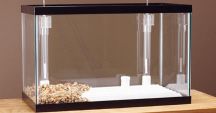For many years, undergravel filters have been the top and most efficient filters for saltwater aquariums.
You cant find any saltwater aquarium that is successful without one.
There are more advanced filtration system nowadays.
Youre right! Filters have evolved! But even if the times have changed, they are still used by many aquarists.
It is still an effective choice for filtration.
But since there are a lot of improvements in the efficiency of filters, less and less aquarist use it because more and more new technology is available.
The Original

The basic ones have a perforated plastic plate that goes on the bottom of the aquarium under the gravel.
Each rear corner of the plate is a lift tube that extends up into the aquarium. Air is pump to the bottom of each lift tube and bubbles that come right back up the tube creating a water vacuum.
The water in your aquarium gets pulled down through the gravel and the filter plate and out the lift tube. Water circulation is then formed from the aquarium down to the gravel.
Your gravel acts as a media when you use this kind of filters. Debris and other particles get trapped into the gravel and provide mechanical filtration.
When bacteria that breaks down harmful ammonia from in your gravel, it provides an excellent biological filtration. This is why certain kinds of gravel are required for this kind of filter.
The only problem when you use this kind of filters is that it will usually get clogged from the debris that was trapped in the gravel. It needs to be routinely siphoned.
Cleaning will be hard if your aquarium has lots of corals and live rocks sitting on the gravel. This is the reason why this kind of filter is not really suited for a reef aquarium.
Another potential problem is that they tend to be noisy and may not be strong enough to provide enough water circulation in the aquarium. Specially when the gravel clogs.
They also dont provide chemical filtration. But carbon cartridges are now available that can fit on the lift tubes.
- The larger plate sizes reduce the number of plates required
- The added strength of the UGF plates makes this filter most preferred by saltwater aquarists
- Size: 12-inch by 48-inch
Reverse flow
Reverse flow of water in the gravel in an undergravel filter will prevent clogging. Efficiency of the media will also be maintained.
How do you reverse the flow?
The common way is by adding another filter. Pump the water from the output of a canister filter down the lift tube of the undergravel filter. This can easily reverse the flow of water. Canister filter will also take care of the mechanical filtration for you.
The reverse flow gravel filter provides an excellent biological filtration without the dilemma connected with the original system.
Powerheads

This is one of the major improvements to the undergravel filters. It replaces the less efficient air-driven system.
The powerhead is a small pump that is sitting on top of the lift tube. It pulls the water through the gravel.
- Increases water flow through a gravel substrate and improves its filtering efficiency
- Provides stronger currents and consistent output over time
- Maximum flow rate of 400 gph
- Silent operation; Powerhead lifts water as well as moves it
- Provides additional safe mechanical filtration
It improves filter efficiency and water circulation in your aquarium. What an upgrade huh?
What about aeration? It comes now with a ventura aerator , which introduces air into the outflow.
Reverse flow powerheads are readily available and you can have a reverse flow undergravel filter without adding a canister filter.
The downside – they dont really provide filtration. They just move the water efficiently.
Fish-only aquariums are the ones that will benefit this type of filter the most. It is not that expensive and provides good biological filtration.
If you are going to use undergravel filters, I would say that the reverse flow is the most efficient. You can use it with powerheads if youd like or with a canister filter for added filtration.
Return from Undergravel Filters to Common Aquarium Filtration
* Disclaimer: Saltwater-Aquarium-Online-Guide.com is a participant in the Amazon Services LLC Associates Program, an affiliate advertising program designed to provide a means for sites to earn advertising fees by advertising and linking to amazon.com, amazon.co.uk, amazon.ca. Amazon and the Amazon logo are trademarks of Amazon.com, Inc. or its affiliates. We may receive a small commission if you click on one of our links and make a purchase. Thank you for supporting Saltwater-Aquarium-Online-Guide.com and helping me make it the best site possible!
Last update on 2024-04-23 / Affiliate links / Images from Amazon Product Advertising API






